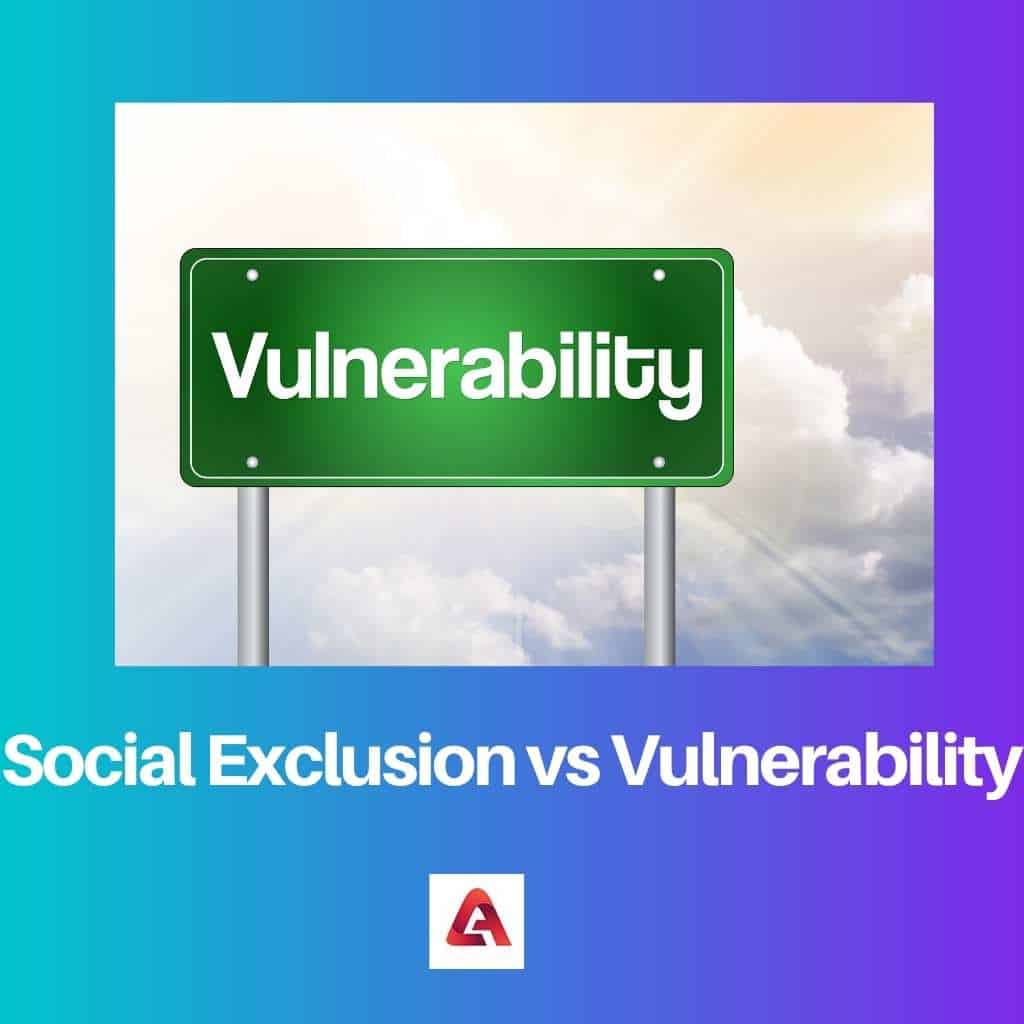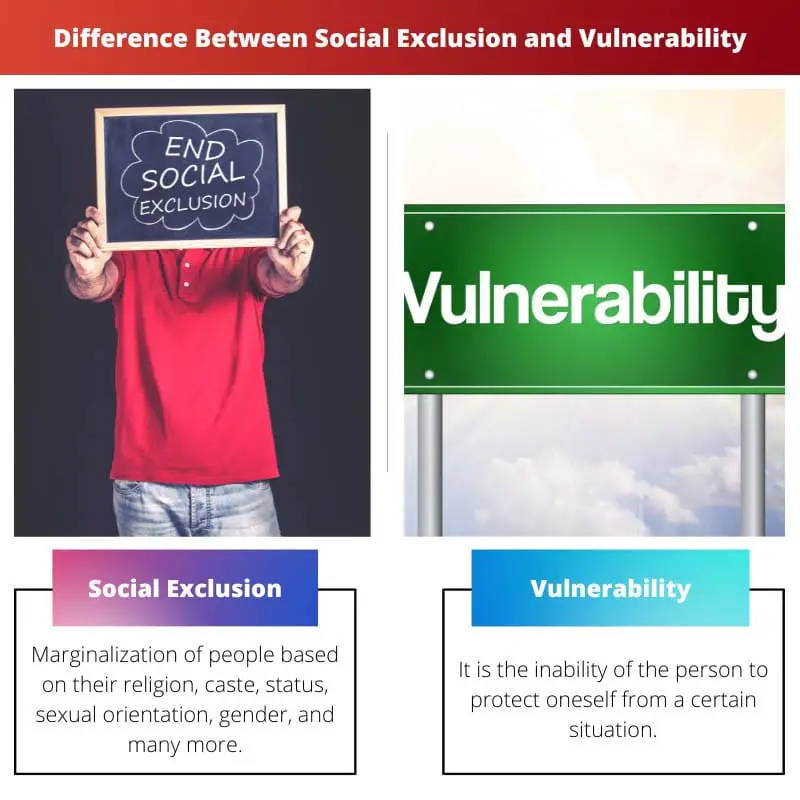Humans are referred to as “social animals.” No human being can exist in this world without the company of friends, families, or other human beings.
Humans require a social life and a standing in the community or society for a variety of reasons. When it comes to human connection, the terms “social exclusion” and “vulnerability” are commonly employed.
Key Takeaways
- Social exclusion refers to the process by which certain individuals or groups are systematically denied access to resources, opportunities, and social networks. At the same time, vulnerability is the susceptibility to harm or adversity due to external factors or personal characteristics.
- Social exclusion can result from discrimination, prejudice, or systemic barriers, whereas vulnerability can stem from poverty, disability, or marginalized status.
- Addressing social exclusion and vulnerability requires targeted policies, social interventions, and inclusive practices to ensure equal opportunities and protection for all individuals.
Social Exclusion vs Vulnerability
The difference between social exclusion and vulnerability is that social exclusion occurs when a segment of the population in society feels isolated and inconsequential. Vulnerability, on the other hand, is when an individual or a group is unable to cope with stressful conditions such as natural disasters, forms of abuse, and a variety of other variables.

When a sector of society is deprived of access to resources, basic rights, prospects for progress, and commodities and services that are accessible to the majority of people, this is known as social exclusion.
Employment, accommodation, healthcare, democratic involvement, and a variety of other elements are all essential for an individual’s or a community’s overall development.
Vulnerability refers to a circumstance in which a person or a group of people is physically wounded, attacked, or psychologically harmed.
Humans may experience these consequences as a result of stressful events in the environment, such as natural catastrophes or maltreatment.
Natural disasters are the primary cause of community disruption, resulting in the loss of lives and property, as well as people’s hard-earned money.
Comparison Table
| Parameters of Comparison | Social Exclusion | Vulnerability |
|---|---|---|
| Definition | Marginalization of people based on their religion, caste, status, sexual orientation, gender, and many more. | It is the inability of the person to protect oneself from a certain situation. |
| Cause | It is caused due to the poverty maximum time. | It is caused due to natural disasters and any abuse. |
| Types | There are two types of social exclusion: individual exclusion and community exclusion. | There are five types of vulnerability: social, military, cognitive, environmental, and emotional. |
| Calculation | It cannot be calculated. | It can be calculated through the risk hazard and pressure release models. |
| Example | Many women and communities are denied access to even the most basic educational opportunities. | An earthquake strikes the village or town, demolishing houses and other structures that are beyond the control of the individual or group. |
What is Social Exclusion?
“Social marginalization” is another term for “social exclusion.” It is a condition in which an individual or a group is denied or unable to obtain entire access to available resources, such as economic and political activities in society.
People are pushed to the margins for a variety of reasons, some of which are prohibited in some nations.
People can be socially marginalized for a variety of reasons, including skin colour, religion, ethnicity, handicap, sexual orientation, and others.
In layman’s terms, social exclusion is sometimes referred to as “discrimination.” This phrase was first used in France in the twentieth century, and it was primarily used in Europe.
This social exclusion is harmful to both individuals and countries since it creates a significant obstacle to progress. This has bad consequences for the community, affects people’s well-being by disrupting their personal lives, and, most significantly, has a negative impact on them.
Many people may be influenced to engage in criminal activity as a result of these effects. People assess people based on their basic characteristics, such as drug usage history, caste, ethnicity, gender, and LGBTQ people are viewed as a social problem, which is incorrect.
For many years, or you could say until now, any woman has been denied access to services such as education, which is a basic human right.
What is Vulnerability?
Vulnerability is a scenario in which a person is attacked or damaged and cannot defend themselves. Vulnerability comes in various forms, including social, cognitive, and military.
Situations that have a negative impact on the community, such as various forms of abuse and a variety of natural climates, are always negative.
Social exclusion is the source of vulnerability. Because of structural causes such as socioeconomic inequality, it exists in society. These events result in a significant loss of life and property for the people involved.
Two types of models, the “Risk Hazard Model” and the “Pressure Release Model,” can be used to calculate society’s susceptibility.
The risk hazard model is a formula for calculating the level of hazard and the sensitivity of that person or community that is exposed to the event. The pressure release model, which is the next model, is used to examine the progression of vulnerability as a result of hazardous occurrences.
The WOV (window of vulnerability) is a period of time during which defensive mechanisms are weakened, compromised, or non-existent.
The term “vulnerability” refers to the expression of the multi-dimensionality of a natural disaster, with an emphasis on the human-environment link.
The everyday changes induced by human activity have a significant impact on people’s climatic conditions. Disasters such as floods, earthquakes, cyclones, and other natural disasters wreak havoc on the environment, destroying everything in their path.
Main Differences Between Social Exclusion and Vulnerability
- Social exclusion is the process of excluding a person or a group of individuals from society by denying them access to facilities. Yet, vulnerability is defined as the incapacity to defend oneself against attack or harm.
- Social exclusion is produced by variables such as caste, religion, sexual orientation, and many more, whereas vulnerability is caused by natural disasters and abuse.
- It is impossible to calculate social exclusion. Vulnerability, on the other hand, can be calculated using two models: the risk hazard model and the pressure release model.
- Social exclusion is difficult to eradicate from society, but vulnerability can be eliminated following a disaster if the government and organizations adopt the appropriate actions.
- Individual exclusion and community exclusion are two types of social exclusion, although vulnerability is divided into five categories: social, military, cognitive, environmental, and emotional.

- https://onlinelibrary.wiley.com/doi/abs/10.1111/j.1468-5973.2005.00457.x
- https://link.springer.com/article/10.1007/s12552-017-9215-z
- https://assets.publishing.service.gov.uk/media/57a08a00ed915d3cfd00052e/hdq959.pdf
